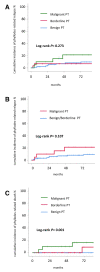Prognostic factors in phyllodes tumours of the breast: retrospective study on 166 consecutive cases
- PMID: 33020219
- PMCID: PMC7537333
- DOI: 10.1136/esmoopen-2020-000843
Prognostic factors in phyllodes tumours of the breast: retrospective study on 166 consecutive cases
Abstract
Background: Phyllodes tumours (PTs) are rare fibroepithelial tumours accounting for <1% of all breast tumours. We assessed clinicopathological features and their prognostic effect in a single-institution patients' cohort.
Methods: Patients diagnosed with PT between 2001 and 2018 at our institution were identified. Clinical, surgical and pathological features were collected. Phyllodes-related relapse was defined as locoregional or distant recurrence (contralateral excluded), whichever first.
Results: A total of 166 patients were included: 115 with benign, 30 with borderline and 21 with malignant PTs. Features associated with malignant PT were younger age, larger T size, higher mitotic count, marked cytological atypia, stromal overgrowth, stromal hypercellularity, necrosis and heterologous differentiation (all p<0.01). The majority of patients with malignant PT underwent mastectomy (63.2% vs 3% of benign/borderline, p<0.001) and had negative surgical margins (83.3%). 4-year cumulative phyllodes-related relapse incidence was 7% for benign/borderline PT and 21.3% for malignant PT (p=0.107). In the entire cohort, marked cellular atypia and heterologous differentiation were associated with worse phyllodes-related relapse-free survival (HR 14.10, p=0.036 for marked vs mild atypia; HR 4.21, p=0.031 for heterologous differentiation present vs absent). For patients with benign PT, larger tumour size was associated with worse phyllodes-related relapse-free survival (HR 9.67, p=0.013 for T>5 cm vs T≤2 cm). Higher tumour-infiltrating lymphocytes (TILs) were associated with borderline and malignant PT (p=0.023); TILs were not associated with phyllodes-related relapse-free survival (HR 0.58, p=0.361 for TILs>2% vs≤2%). Overall, four patients died because of PT: three patients with malignant and one with borderline PT.
Conclusions: Patients with malignant PT had increased rates of phyllodes-related relapse and phyllodes-related death. Cellular atypia and heterologous differentiation were poor prognostic factors in the entire cohort; large tumour size was associated with an increased risk of phyllodes-related relapse in benign PT.
Keywords: breast; histological classification; phyllodes tumours; phyllodes-related death; phyllodes-related recurrence.
© Author (s) (or their employer(s)) 2020. Re-use permitted under CC BY-NC. No commercial re-use. Published by BMJ on behalf of the European Society for Medical Oncology.
Conflict of interest statement
Competing interests: MVD declares personal fees for consulting/advisory board from Eli Lilly, Celgene and Genomic Health. APDT declares personal fees for advisory boards/speaker’s bureau from PharaMAr, Lilly, Roche, Bayer and Pfizer. PFC reports grants (Institution) from Agenzia Italiana del Farmaco AIFA, Merck KGa and BMS; personal fees for consulting/advisory board from Novartis, EliLilly, AstraZeneca, Tesaro and Roche. VG reports grants (institution) and personal fees for consulting/advisor from Roche; personal fees for consulting/advisory relationship from Novartis and Eli Lilly. All the disclosures are outside the submitted work. All other authors declared no conflicts of interest.
Figures
References
-
- WHO Classification of Tumours In: Breast tumours. Volume 2 5th Edition, 2019. https://publications.iarc.fr/581
MeSH terms
LinkOut - more resources
Full Text Sources
Medical


